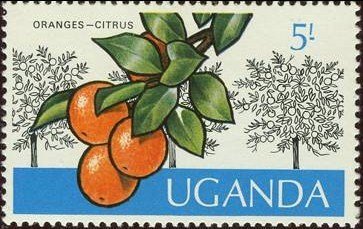Stamp: Oranges (Uganda 1978)
Oranges (Uganda 1978)
01 January (Uganda ) within release Crops goes into circulation Stamp Oranges face value 5 Ugandan shilling
| Stamp Oranges in catalogues | |
|---|---|
| Michel: | Mi:UG 175 |
Stamp is square format.
Blue bar with country nameAlso in the issue Crops:
- Stamp - Oranges face value 5;
- Stamp - Peanuts face value 10;
- Stamp - Cotton face value 20;
- Stamp - Beans face value 40;
|
Data entry completed
60%
|
|
|---|---|
| Stamp Oranges in digits | |
| Country: | Uganda |
| Date: | 1978-01-01 |
| Print: | Offset and Lithography |
| Perforation: | comb 14½ |
| Emission: | Definitive |
| Format: | Stamp |
| Face Value: | 5 Ugandan shilling |
Stamp Oranges it reflects the thematic directions:
A crop is a plant that can be grown and harvested extensively for profit or subsistence. In other words, crop is a plant or plant product that is grown for a specific purpose such as food, fibre or fuel.
When plants of the same species are cultivated in rows or other systematic arrangements, it is called crop field or crop cultivation.
Agriculture is the cultivation and breeding of animals, plants and fungi for food, fiber, biofuel, medicinal plants and other products used to sustain and enhance human life.[1] Agriculture was the key development in the rise of sedentary human civilization, whereby farming of domesticated species created food surpluses that nurtured the development of civilization. The study of agriculture is known as agricultural science. The history of agriculture dates back thousands of years, and its development has been driven and defined by greatly different climates, cultures, and technologies. Industrial agriculture based on large-scale monoculture farming has become the dominant agricultural methodology.
In botany, a fruit is the seed-bearing structure in flowering plants (also known as angiosperms) formed from the ovary after flowering. Fruits are the means by which angiosperms disseminate seeds. Edible fruits, in particular, have propagated with the movements of humans and animals in a symbiotic relationship as a means for seed dispersal and nutrition; in fact, humans and many animals have become dependent on fruits as a source of food. Accordingly, fruits account for a substantial fraction of the world's agricultural output, and some (such as the apple and the pomegranate) have acquired extensive cultural and symbolic meanings. In common language usage, "fruit" normally means the fleshy seed-associated structures of a plant that are sweet or sour, and edible in the raw state, such as apples, bananas, grapes, lemons, oranges, and strawberries. On the other hand, in botanical usage, "fruit" includes many structures that are not commonly called "fruits", such as bean pods, corn kernels, tomatoes, and wheat grains. The section of a fungus that produces spores is also called a fruiting body.



